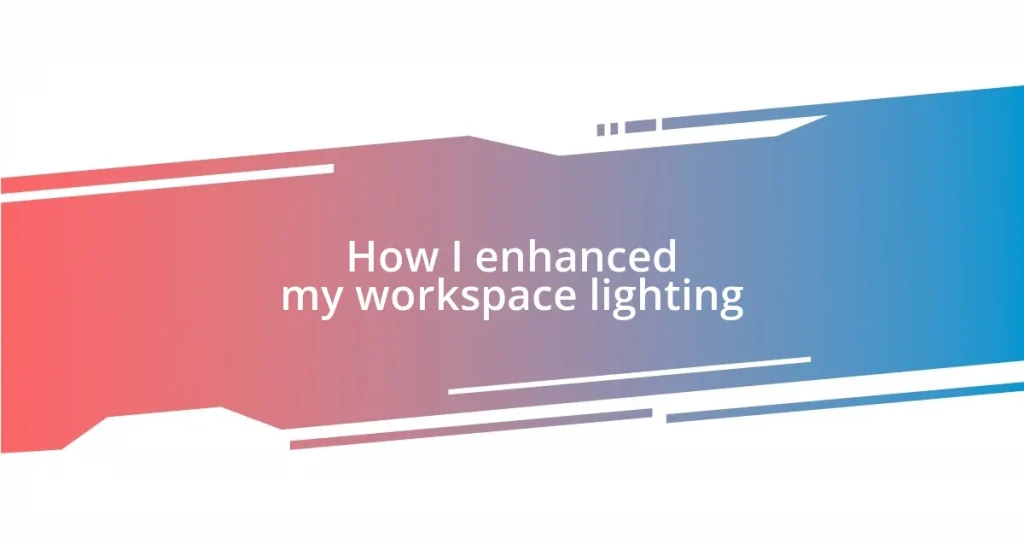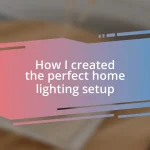Key takeaways:
- Good workspace lighting enhances mood and productivity, with softer lighting promoting comfort and focus.
- Assess current lighting quality by evaluating brightness, color temperature, shadows, layering, and positioning.
- Incorporating natural light and the right light fixtures can significantly improve your workspace environment.
- Utilizing smart lighting solutions allows for customizable settings to match different tasks and enhances energy management.
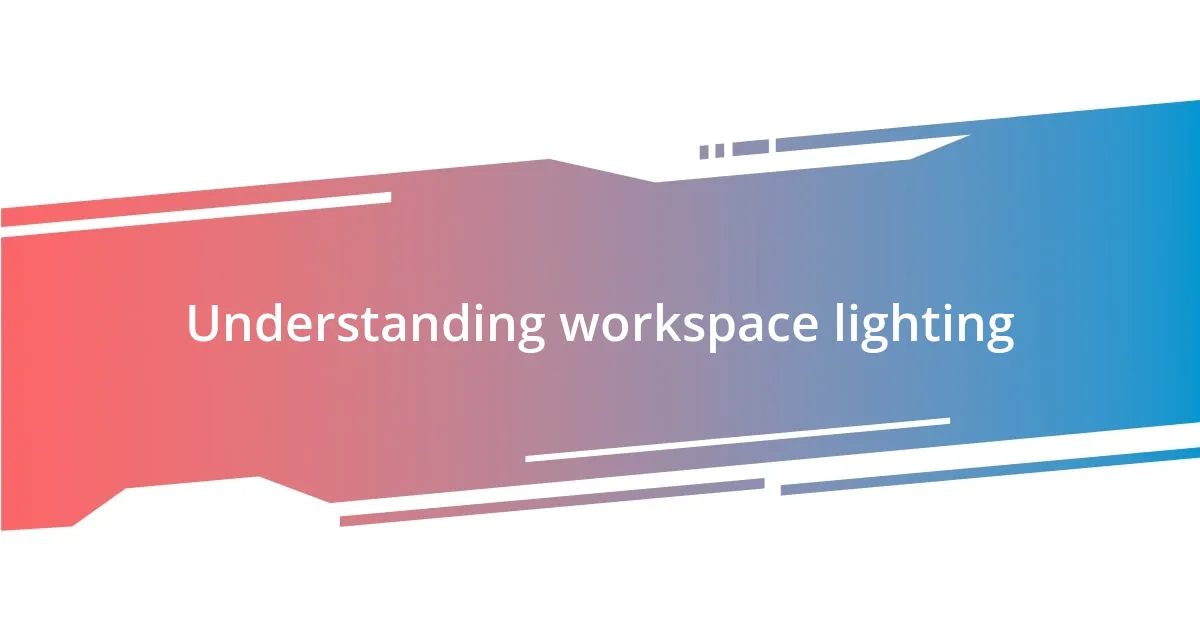
Understanding workspace lighting
When I first started working from home, I underestimated the importance of good lighting. I remember sitting at my desk under a single overhead bulb that cast harsh shadows, making me feel drained and unproductive. Have you ever noticed how some spaces just feel right? That’s often about the lighting!
As I began to explore different options, I learned that workspace lighting goes beyond mere visibility; it can significantly impact my mood and focus. For instance, switching to softer LED bulbs transformed my workspace into a cozy haven, enhancing my creativity. It’s fascinating how something as simple as adjusting the color temperature can shift my entire work vibe.
Additionally, layering my lighting—using task lamps and ambient lights—allowed me to create the perfect setting for different tasks. I find that when I have dedicated task light for reading or working on a project, I can truly dive into my work without distractions. Can lighting really influence productivity? Absolutely! It’s all about how we feel in the space we create around ourselves.
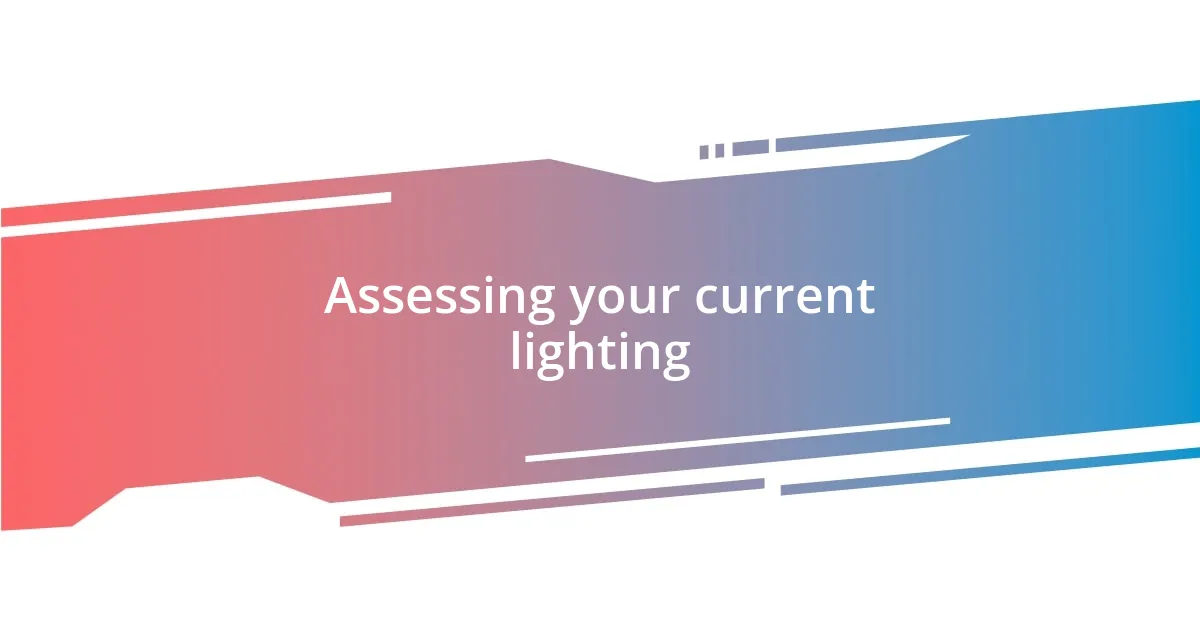
Assessing your current lighting
To assess your current lighting, start by taking a moment to observe how the light affects your work experience. I recall the time I realized my workspace was dim, causing me to squint at my screen and strain my eyes. This not only led to discomfort but also made my tasks seem more tedious. Pay attention to how your lighting impacts your mood and productivity throughout the day.
Here’s a quick checklist to help you evaluate your current setup:
– Brightness: Is your space well-lit, or do you find yourself relying on natural light?
– Color Temperature: Are your bulbs warm (yellowish) or cool (bluish)? How does it make you feel?
– Shadows: Do you notice any harsh shadows that disrupt your focus?
– Layering: Are you using different types of light, like ambient and task lighting, to create depth?
– Positioning: Are your light sources properly positioned to reduce glare on screens?
Taking these factors into account can guide you in enhancing your workspace lighting effectively.
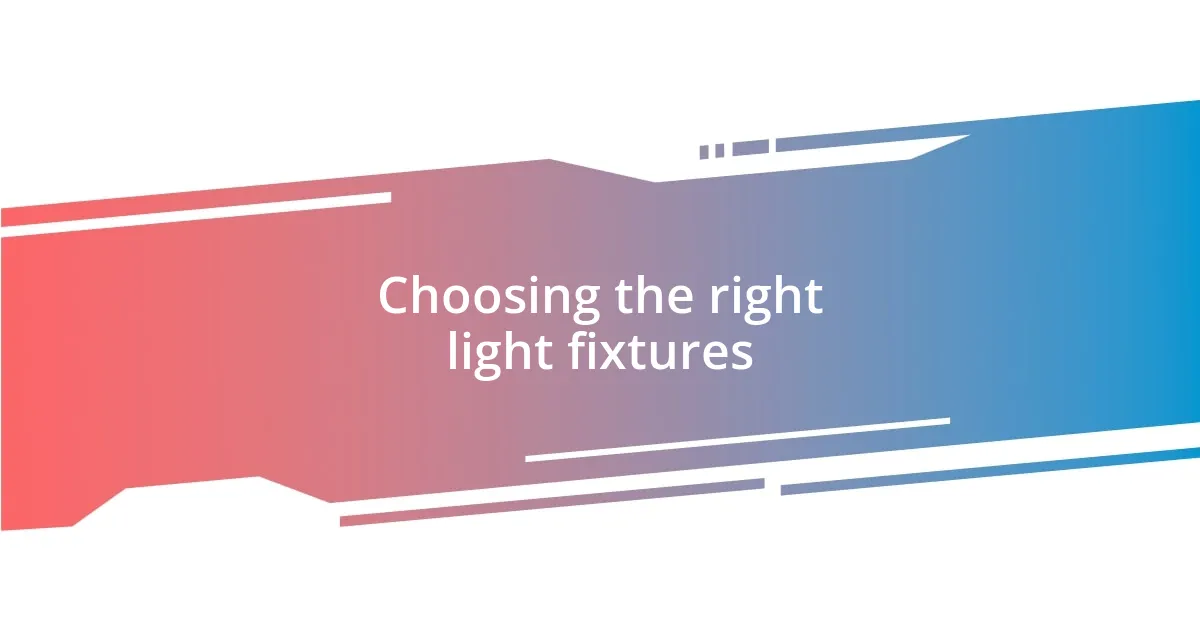
Choosing the right light fixtures
Choosing the right light fixtures is crucial when creating an inviting workspace. I remember the first time I swapped my old, flickering desk lamp for a sleek, adjustable LED one. The difference was night and day! Not only did the LED lamp provide better illumination, but it also allowed me to direct the light precisely where I needed it most. The ability to adjust the brightness made long hours at my desk far more comfortable.
When exploring fixture options, consider the purpose of each light. For instance, task lights need to be focused and bright, while ambient lighting can be softer and more diffused. I often compare my workspace lighting to a well-composed photograph; it’s all about balance and mood. I once tried using only overhead fixtures, and it created a sterile feeling that zapped my creativity. In contrast, a combination of wall sconces and a stylish floor lamp created warmth and inspired me to spend even more time in my productive nook.
Lastly, aesthetics shouldn’t be overlooked. Finding fixtures that resonate with your personal style can make your workspace feel more like your own. I often gaze at my stylish pendant lights, which double as art pieces and functional tools. It’s amazing how a well-chosen design can uplift the whole vibe of your workspace, making even the most mundane tasks feel special.
| Fixture Type | Best Use |
|---|---|
| Task Lighting | Focused work (reading, writing) |
| Ambient Lighting | Overall brightness (relaxation, comfort) |
| Accent Lighting | Highlighting decor or features |
| Natural Light | Boosting mood and productivity |
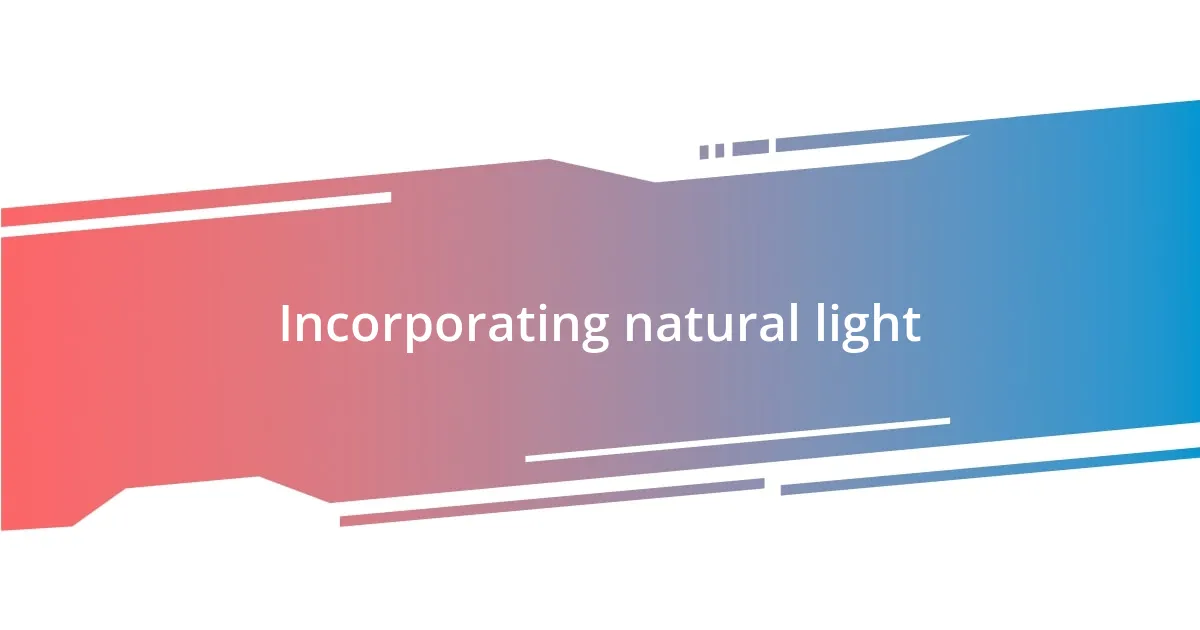
Incorporating natural light
Incorporating natural light into your workspace can truly transform your experience. I remember when I rearranged my office to take advantage of the large window I had almost ignored. The morning sun began flooding in, and suddenly my mood lifted, and I felt more energized to tackle my projects. Have you ever noticed how a little sunlight can change your perspective?
Another advantage of natural light is its ability to enhance focus. I found that on days when the sun streamed through my window, I was far more productive than on gloomy, overcast days. It’s fascinating how nature plays such a vital role in our well-being. I often ask myself, “Why not harness this gift of daylight?”
To maximize natural light, consider your furniture placement. I shifted my desk closer to that inviting window, and now I catch glimpses of the outside world from my chair. It’s amazing how quickly a little greenery or a view of the sky breaks the monotony of a workday, making tasks feel less daunting and even enjoyable. If you haven’t experienced this shift yet, it might be time to rethink your setup.
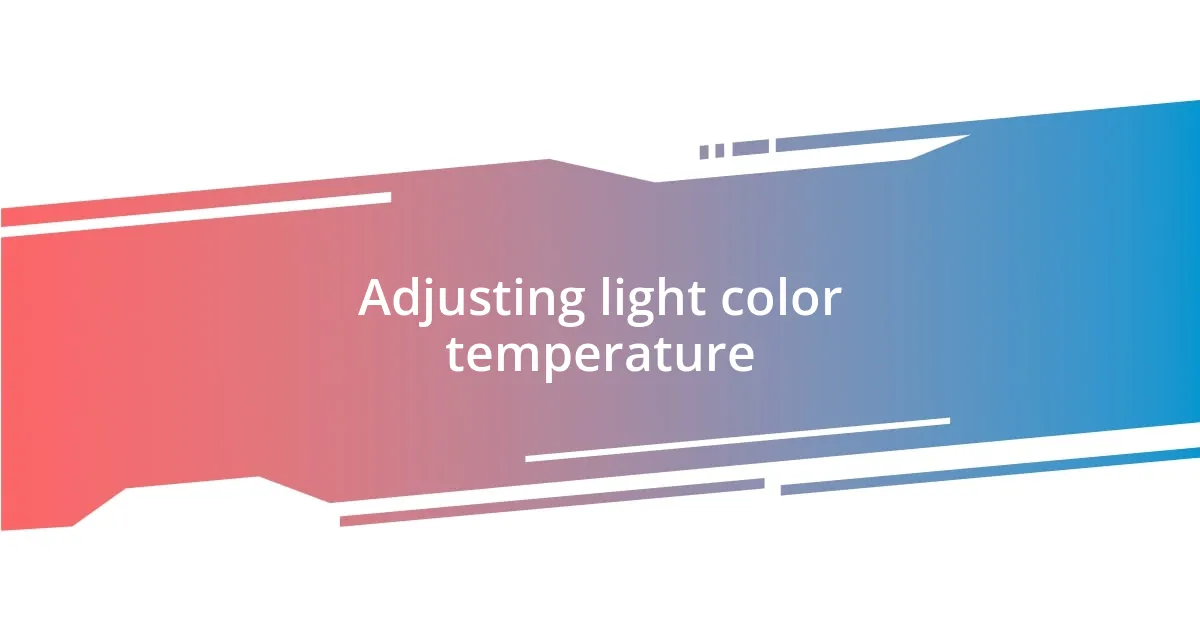
Adjusting light color temperature
Adjusting the color temperature of your lighting can profoundly affect your workspace vibe and productivity. I distinctly recall my initial struggle with a warm, yellowish light that left me feeling drowsy and unmotivated. Switching to a cooler, bluish tone not only brightened my surroundings but invigorated my focus. Have you ever experimented with light settings? I encourage you to give it a try, as the right color temperature can uplift your energy levels significantly.
The science behind color temperature is quite fascinating. Measured in Kelvin (K), lower temperatures (around 2700K) emit a cozy, warm light, perfect for relaxation, while higher temperatures (4000K and above) mimic daylight, enhancing alertness for tasks that require concentration. I remember a day when a simple toggle on my LED fixture transitioned my workspace from a relaxing haven to a productive powerhouse—what a game changer! It felt as if I suddenly had the sun on my desk, and the shift in mood was instantaneous.
Moreover, adjusting color temperature can even influence my creative processes. On days when I need to brainstorm or think outside the box, I opt for that cooler light. It feels as if the blue tones spark my imagination and invite fresh ideas to flow. How do you feel when you change the color of your lighting? Experimenting with both cooler and warmer tones throughout the day has led me to a deeper understanding of my personal preferences and working patterns—it’s a little tweak that yields big results!
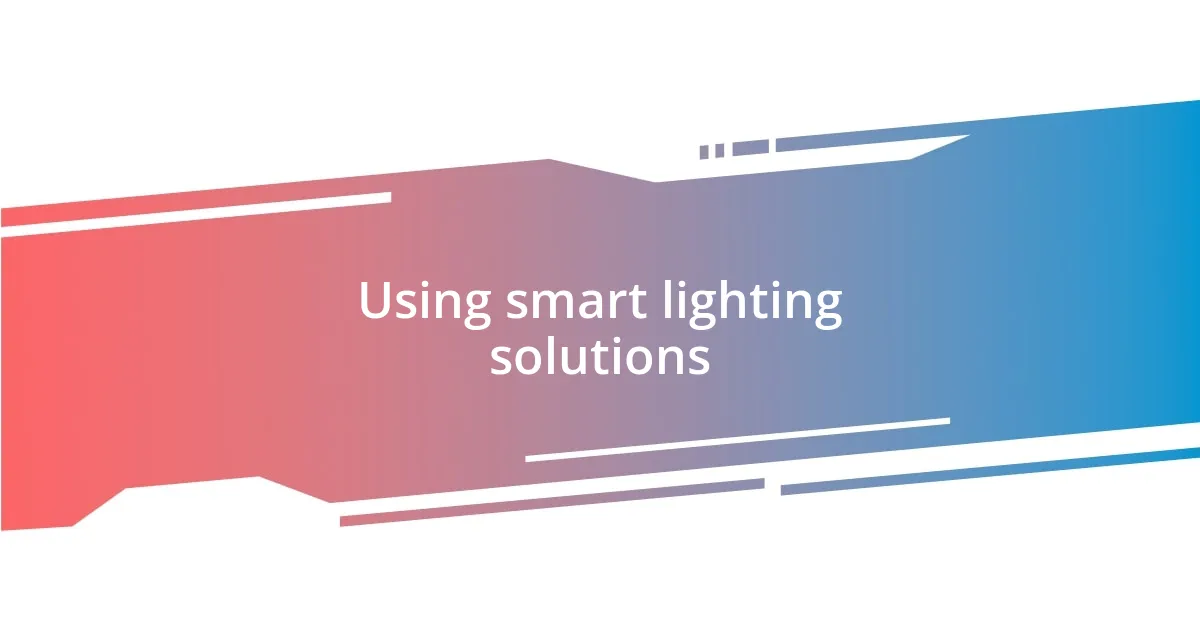
Using smart lighting solutions
Utilizing smart lighting solutions in my workspace has been a revelation. I’ve installed smart bulbs that I can control from my smartphone, which means I can adjust the brightness or color right from my couch when I’m in that mid-afternoon slump. Have you ever found yourself wishing the light was just a bit brighter or more inviting? With a simple tap on my screen, I can create the perfect ambiance without leaving my seat.
After experimenting with different smart lighting options, I discovered the magic of automated schedules. I programmed my lights to gradually brighten in the morning, mimicking a natural sunrise. That gentle wake-up call not only feels more pleasant than a loud alarm but also sets a positive tone for my day. How often do we forget the impact of a smooth start? I now feel more refreshed and ready to tackle my tasks with a clear mind.
Another fantastic feature I love is the ability to change my lighting based on the task at hand. When I’m focused on a detailed project, I switch to a cooler setting that boosts my concentration, while soft, warm hues create a cozy vibe when I’m winding down. I can’t help but wonder how many others have explored this dynamic lighting flexibility. It’s fascinating how these small adjustments in lighting can align with my energy levels and productivity—who knew light could be such a versatile tool in achieving my work goals?
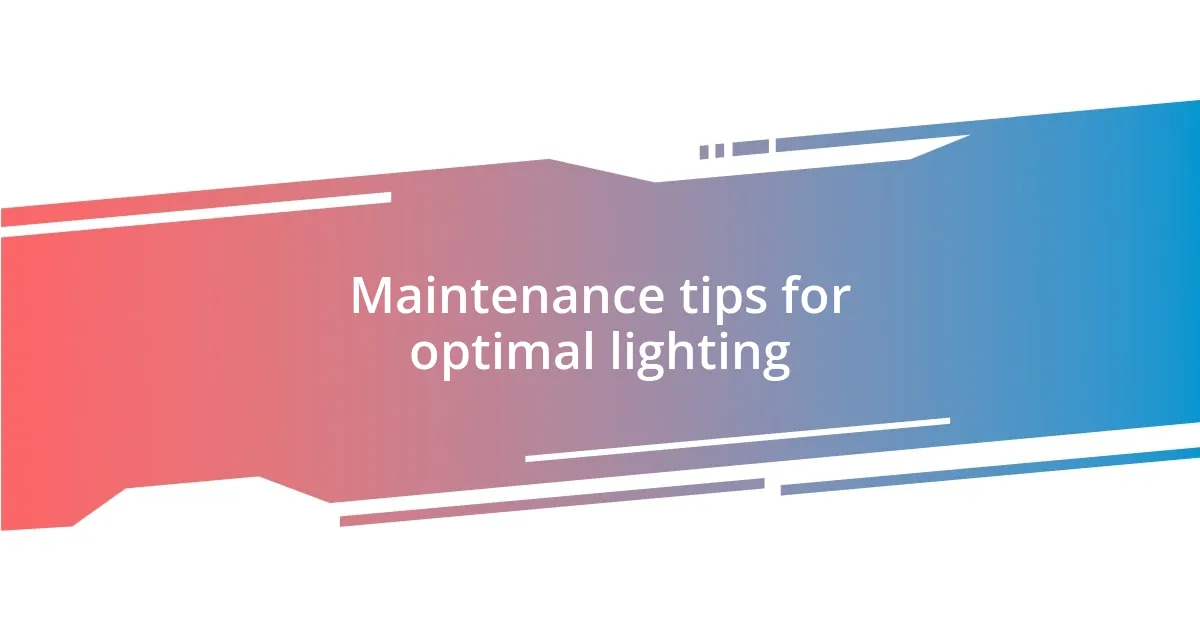
Maintenance tips for optimal lighting
Maintaining optimal lighting in my workspace involves a few straightforward yet essential tasks. One of my go-to tips is to regularly clean light fixtures and bulbs to ensure maximum brightness. I’ve noticed that even a thin layer of dust can significantly mute the light’s efficacy and alter the mood in my environment. Have you ever experienced that dimming effect after a few weeks? A simple wipe-down can restore the glow and make your workspace feel fresher and more inviting.
Another aspect I prioritize is replacing any flickering or dim bulbs immediately. I’ve learned that a consistent brightness not only enhances my focus but also reduces strain on my eyes. When I had a stubborn bulb that stubbornly flickered, I found it distracting and irritating, ultimately impacting my productivity. By proactively replacing these troublesome fixtures, I create a smoother, more harmonious workspace that encourages creativity instead of irritation.
Lastly, I find it beneficial to periodically reassess my lighting setup based on changing seasons and tasks. During darker days, I tend to rely more on bright, cooler lights, while in sunnier months, I often dial it back and lean on natural light. I remember feeling overly cozy in my workplace one summer, only to realize the lighting was too soft for the active projects I was engaged in. Keeping a pulse on how my environment changes can lead to adjustments that bolster my productivity and, quite honestly, just make me feel better while I work. How do you adapt your lighting to fit your needs throughout the year? It’s intriguing how tailored lighting can make such a difference in our day-to-day work experiences.










